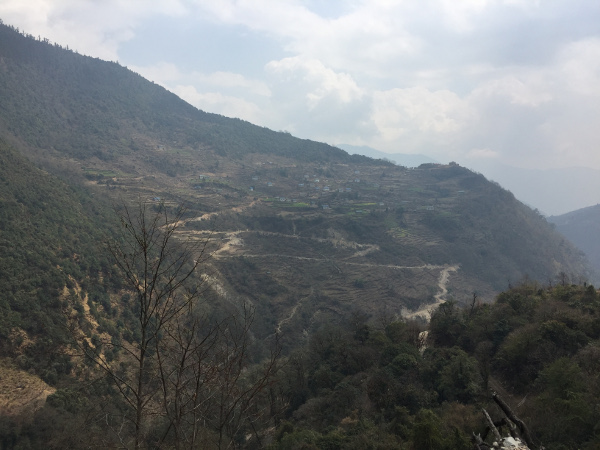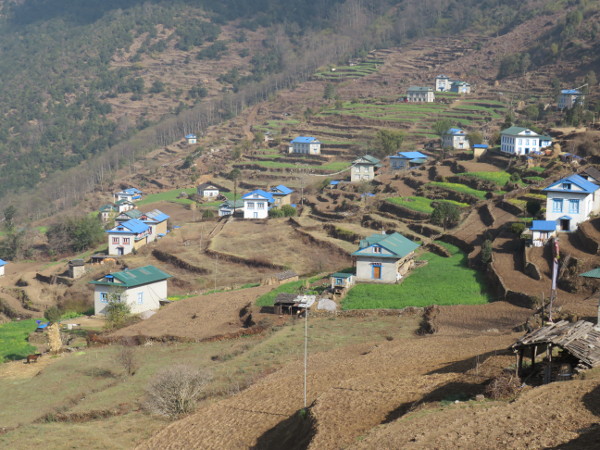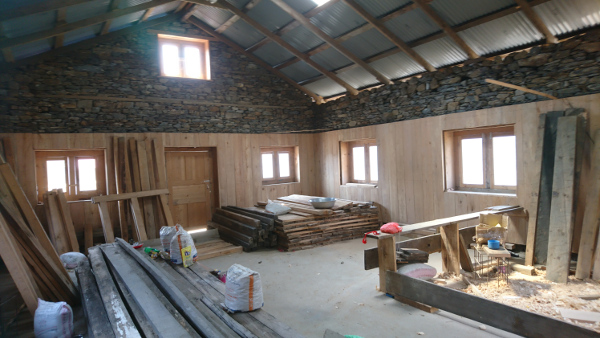
formerly Taksindu VDC 6, Solukhumbu, Nepal
now part of Solududhkunda Municipality 1
 |
The
village
of Hewa (Yawa) formerly Taksindu VDC 6, Solukhumbu, Nepal now part of Solududhkunda Municipality 1 |
|
Hewa (in Sherpa language Yawa) has been one of the villages of Taksindu VDC. Taksindu itself is a hamlet with both a Buddhist monastery, that has very much been extended in recent years, and a small nunnery situated at a height of about 3.000 meters. Until 2017, Nepal's local administration units had been called Village Development Committees (VDC). With the administrative reform of 2017, the whole of Taksindu VDC became part of Solududhkunda Municipality, the centre of which is at Salleri. The area is part of the district of Solukhumbu where Mount Everest (Nepali: Sagarmatha, Sherpa: Cholomungma) is located. The former Taksindu VDC has an area of 166.9 km² and is home of about 2.100 people who live in 530 households. In 2015, the education rate has been 62 per cent.

The closest metalled airport is at Phaplu, about half a flight hour East of Kathmandu [This is how Phaplu Airport looked before (March 2011)]. From Phaplu, walkers need about half a day to reach the village of Ringmu at the foot of Taksindu Pass (Sherpa: Taksindu La). Up to the Taksindu monastery, they need another two hours. Of course, locals are faster.
Besides, Phaplu can now also be reached from Kathmandu by road within 8-10 hours. From Phaplu, the extension of the road to the Dudh Kosi valley is under construction. The unpaved road has been so well improved in the meantime that it is passable with jeeps up to the Dudh Koshi. From above Chhulemu there is even a dirt road to Hewa since March 2019 [see video of jeep ride from Phaplu to Hewa (March 2019)]. Instead of one and a half days on foot, the distance from Phaplu to Hewa can be done in about two and a half to three hours by jeep. Related to the number of inhabitants, Hewa is the biggest village of the former Taksindu VDC. Originally, the Sherpa name of the village had been Yawa, but since the administrators generally have problems (or disinterest?) with ethnic languages and cultures, they have renamed the village as Hewa.

Hewa with its 54 houses is currently inhabited by ome 400 persons. But the migration rate is high. Especially young villagers have gone to Kathmandu valley in recent decades where they have found a home from home. Nevertheless, they have remained in close contact to their village and regularly return there. Similar to other Nepalis, some young people from Hewa have sought greener pastures in India, the Gulf states, Malaysia and Korea in the form of labour migration. A few have even ended up in Europe, North America, Australia or Japan.
Unlike other villages of the former Taksindu VDC, Hewa is exclusively inhabited by Sherpas. This has helped its inhabitants to conserve and promote their Sherpa culture. In recent decades, Hewa has seen rapid changes. In the mid 1970s, there had been only 22 houses in the village. But they had been homes of much bigger families. At that time, it had been normal that families had 10 or more children but the child mortality was also high. Today, most of the young families have only 2-3 children whose chance of survival is a lot better.
Forty years ago, nobody thought about clean and running drinking water, toilets or electricity. Defecation was done in the open fields. Women and children fetched drinking water from the few springs within the village. All houses had open fireplaces where firewood was used for cooking. Children often got heavy burns or even died when they fell into these fires. The required wood was collected from the surrounding forests that got decimated over the years. There were no window panes and the small window cases were sealed up with paper or wood. The roofs of the houses were generally covered with timber shingles that often became leaky and had to be replaced. There were no chimneys so that the houses were filled with smoke what led to respiratory ailments.
Modern communication media were hardly available even in Kathmandu in the 1970s and they were obsolete in Hewa. To listen to the then only radio station of the country, Radio Nepal, was only theoretically possible. Useless to say, that newspapers were also not available. There was a small village school with two rooms but it had neither a roof nor windows nor doors and, with exception of two wooden benches, no other equipment. There were two or three teachers who hat been sent there from far away; they were unable to understand the mother tongue of the school children.

How different the village looks today! Most of the two-storeyed houses are more stable, bigger and better equipped. All the newer houses have chimneys and most of them are separated into several rooms. The roofs are covered with corrugated iron sheets, into which translucent fields are integrated that provide for light in the kitchen that is normally below the roofs of the Sherpa houses. Since 2006, almost all the houses have running water inside provided by a nearby spring. All the houses have toilets which are usually placed a few meters away from the house. Only a few of them are still earth closets. Most are now squat toilets that are embedded in concrete floors.
The small paths within the village have been improved considerably. Of course, instead of wooden torches, the villagers use hand or forehead lamps when they walk through the village after sunset. But today, the village is also not as dark at night as it had been before. Since 2010, Hewa and the neighbouring villages are connected to a small hydroelectric facility that provides the people with power 24 hours a day. So, the locals can work or talk even hours after sunset. This has influenced their daily routine considerably. If you stand in front of the Taksindu monastery in the evening and look down at the villages on the surrounding mountain slopes, then you have a similar view as in alpine regions in Europe.
The school has been improved as well. A French NGO, Népal
et vous, has constructed a primary school with five classrooms. And
there is an annexed building where the teachers can live. Three
teachers have been transferred there from partly faraway places ever
since the 1970s. In recent times, the teachers stayed there for many
years and even had learnt to speak Sherpa language. They were fully
integrated and respected by the village community and participated
in all village events. For two years now, the headmaster of the
school is a Sherpa. The other teachers have also changed in 2019. As
the number of schoolchildren has fallen sharply in recent years due
to the declining birth rate, long-term concerns about the continued
existence of the school are justified. The problem, however, is that
the daily walk to the schools on the opposite side of the valley
would be too far for primary school pupils. Many rural areas of
Nepal are currently facing similar problems.
The American organisation Hike for Help had organised a health camp in Hewa in December 2015 that had been very well frequented by the village people. This is why Hike for Help has decided to construct a health centre in the village that is already under construction. HSCC is not involved in this project. The building of the health centre has already been constructed nearby the just finished socio-cultural community centre building. Even though the buildung of the healthpost has already been complete for at least two years, it is still not used because of administrative rasons from the side of the Nepalese government.

The community centre has been a common initiative of HSCC as well as Lhakpa Doma Sherpa, a daughter of the village who went to Germany in 1965, and her husband Karl-Heinz Krämer (Tsak). The village centre project has been kindly supported by the German Nepal Friendship Association (Deutsch-Nepalische Gesellschaft e.V.), Cologne with financial help from the German Ministry of Economic Cooperation. The framing of the building has been concluded in July 2016; it ha been officially inaugurated in November 2017 [see also slideshow and a dance from the same event]. The outside painting of the two buildings has been done in 2019 (as it can be seen on the picture below). The completion of the interior is still underway. The community centre is already frequently used as a meeting place by the inhabitants of the village. In the end, it shall also include a small library and a computer room.
In the attached smaller building that will probably be completed in 2019, there will be a kitchen on the ground floor that can be used for all activities at the centre. In its upper floor will be three rooms including lavatory and toilet for passing travellers. The income shall contribute to the maintenance of the centre.

Since March 2019, a kindergarten has been constructed between healthpost building and community centre by HSCC with financial support from zwo German NGOs, Nepal-Inzlingen and Rheinland-Lorraine-Nepal; they had got some support from a German Foundation, the Fürsorge- und Bildungsstiftung (FBS). The kindergarten is going to be inaugurated in November 2019 when a group from the two German NGOs will visit the village.
Both these NGOs, once again with great financial help from FBS, have also supported the reconstruction and repair of houses that had been damaged by the big earthquake of 2015. About 20 per cent of the village houses had been uninhabitable. The German NGOs provided about 85 per cent of the costs to the affected households. The reconstruction of a stable and earthquake resistant house in this distant high mountain area proved to cost 13 to 14.000 Euros (more than 1.6 million Rs.).
The aid was not paid directly to the families, but the local partner organisation HSCC covered the material and wage costs with the funds transferred by the German organisations. Of course, the families could increase their own share of the costs if they wished. The bottom line is that the new houses are somewhat smaller than the old ones, but more stable and comfortable. The reconstruction and repair of all houses will be completed by the end of 2019. This was only possible thanks to the support of the German organisation. The villagers are still waiting for a large part of the state aid money promised more than four years ago, which was actually intended to reduce their own share in the costs.
All foreign aid has been invaluable for the development
of Hewa and the reconstruction of homes after the 2015 earthquake.
But this must not hide the fact that all this would not have been
possible without the great interest, commitment and cooperation of
the inhabitants of the village. Not only have they provided
countless unpaid working hours for all projects, but they have also
repeatedly supported the latter financially as far as possible. Such
donations came partly also from the neighbouring villages. The
provincial government in Biratnagar and the city administration in
Salleri have supported the projects financially as well in recent
time. The donations from abroad would not have been sufficient for
any of the projects. All this was only possible thanks to the
untiring work and commitment of the HSCC, especially of its chairman
Chhiri Tendi Sherpa.
Modern communication media have reached Hewa for long. Especially most of the young people nowadays have mobile phones by which they can communicate among themselves. Thanks to the well developed Nepali mobile phone network as well as applications like Skype, Viber and Facebook, communication with people in Kathmandu or even far away countries is possible without greater costs. In other words, Hewa has already become part of the global network.
This has also influenced the daily life and culture of
the people. Probably it becomes especially apparent from the way the
young people dress themselves. And also the behaviour of the youths
during festivities conforms more and more to what we can see in
Kathmandu [see dancing
girl in the vommunity centre in November 2018]. But despite
such unavoidable changes has the fostering of traditional Sherpa
culture increased as one can observe during village festivals like
Losar ( Sherpa New Year).